Thursday, December 29, 2005
Blogger Reality Check
The reality is blogging takes time, time that I could be doing something else. At this very moment, I have today's New York Times which I've only glanced at and a Washington Post that I've only briefly scanned. There are two articles I know I want to read all the way through. Did I mention that I spent about 15 minutes with the Richmond Times-Dispatch over a late morning breakfast?
Where is a person supposed to find time to update a blog when he/she has all the other media-related tasks to do? And, I'm on winter break-- somewhat of a working vacation as I have packed two writing projects on which to work over the three weeks.
So, back to the question at hand-- when is someone supposed to have time to blog?
If you have the answer, let me know. Maybe I'll be more consistent the remaining days of 2005.
We'll see. Dinner's almost ready-- so I'll cut this posting short.
Monday, November 07, 2005
SW Symposium Wraps Up
Saturday, November 05, 2005
Journey to the Rocky Mountains
Yes, at least an inch of snow is on the ground up there. It's been years since I stepped foot into an inch of snow.
After our journey to the Rocky Mountain National Park, we came back down the mountain to Estes Park where we were treated to a fabulous lake trout dinner and tour of the historic Stanley hotel, which we learned tonight was the FIRST hotel in the nation to have electricity.
I'm worn out-- more later.
Lillie and I Present
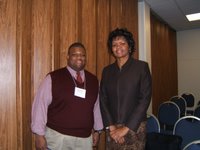
The highlight of the weekend --- our presentation(smile) is now over Here you see a post-presentation two-shot of Dr. Lillie Fears and me. Lillie is one of the people who makes me look REALLY short.
A researcher on political proganda, race and gender, Dr. Fears is currently the Vice Chair for the Minorities and Communication Division of the Association for Education in Journalism and Mass Communication.
We had some snow flurries this morning here at the University campus. But the sun is out and it's clearing up nicely now. More later from Colorado.
Friday, November 04, 2005
SW Symposium Begins

After a morning of seeing downtown Greeley and chatting with the editor of the Greeley Tribune, the OFFICIAL business of the 2005 Southwest Symposium begins.
Minutes from now, the first panel of the symposium will begin here in the University Center of the University of Northern Colorado.
In the photo, you see members of the University of Northern Colorado faculty and staff assisting conference registrants as they pick up their badges.
The Southwest Education Council for Journalism and Mass Communication started in the state of Texas. But, today the organization includes those from journalism/mass communication programs in Oklahoma, Texas, Colorado, Arizona, Arkansas, Louisiana, Wyoming and I know I'm forgetting some of the states.
As a co-author of a paper from a colleague from Arkansas, I am ALSO participating in this meeting.
More to come later on what emerges from the sessions.
Visiting Downtown Greeley
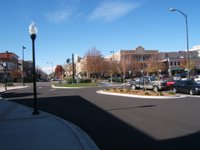
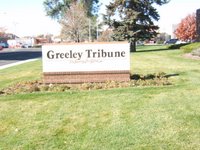
What a GREAT time I had this morning with Mr. Randy Bangert, the Managing Editor of the Greeley Tribune.
I also got a chance to spend an hour walking the streets of Downtown Greeley. I stopped by the Weld County/Greeley Chamber of Commerce and picked up some very good background info. .. even had an informal interview with someone about the recent tax vote in Colorado. More on that later as well.
I spent about an hour with Mr. Bangert talking about some of the things happening at his newspaper in a town that is growing and changing by leaps and bounds.
My thanks to his editor, Chris Colber, who's on a Nieman fellowship this year, who paved the way for my visit today.
Randy not only talked about some of history of this town, which is part of Weld County, named recently as one of the fastest growing counties in that nation.
Thursday, November 03, 2005
First Impressions of Colorado
It's hard to believe it's been 10 years since the new DIA-- Denver International Airport opened. I vividly remember writing multiple updates on the FAILED baggage system at DIA in 1995.
Coming into the airport today-- on a DIRECT flight from Atlanta, I was relieved to pick up my bag without incident.
The shuttle ride from DIA to Greeley (about an hour's drive north) took nearly 90 minutes as there were TWO LEGS to the trip. The shuttle ride required me to transfer to second van in Loveland, Colorado. Along the way, I got a chance to see some of the commercial ventures from the WEST that we don't have (or used to have)" back East."
Besides, the Western U.S. version of Hardees-- called Carl's Jr, there are others..
The first of these is the SEARS GRAND store, which is the retailer's answer to the Wal-Mart SuperCenter and the Super-Target. We didn't stop at the store just northeast of the airport. But, it's been reported that the Sears Grand concept started here in the Western U.S. with the first store opening in Salt Lake City.
Another blast from the past--- Safeway Supermarkets (which used to operate in my home state of Virginia and in Washington, DC) STILL operate here in Colorado. It was great to see the old Safeway.
The big story here today is the aftermath of several referenda on the ballot across the state--one of which legalized marijuana in city of Denver. Police say since most arrests are made under state law, don't expect much to change. Still, the Denver vote is NATIONAL news as it joins Oakland, Calif. and Seattle, which also took votes on this issue.
The Post, which publishes a PM edition of the paper on its website, focuses on what Colorado legislators are doing. What a delight to come to a two-newspaper town (at least for now) as the Scripps (which recently shutdown its afternoon paper in Birmingham) publishes The Rocky Mountain News.
The Rocky Mountain News today reports that the weather guy at CBS affiliate, KCNC, is retired to guess where? Alabama. How's that for a connection back home.
Tuesday, November 01, 2005
Geared Up for Greeley
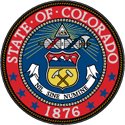
In just 36 hours, I will be making my first trip to the Centennial State. I've read about, heard about happenings in the State of Colorado. But, this week, I'll see it with my own eyes.
While I'll be flying into Denver, my trip takes me north of the state capital to the city of Greeley, home of the The University of Northern Colorado.
The occasion for my visit, the Southwest Symposium, which is sponsored by the Southwest Education Council in Journalism and Mass Communication.
Dr. Lillie Fears, who teaches journalism at Arkansas State University, and I will present our paper entitled "So What Can You Do?: Perceived Entry-Level Journalism Skills of Mass Communication Students."
The conference concludes with a visit to Rocky Mountain National Park and a closing dinner at the historic Stanley Hotel in Estes Park, a mountain town in Colorado.
Thursday, October 27, 2005
Pres, Mrs. Bush Visit My Alma Mater

Nearly a week after the University of Alabama was all excited about Condi Rice's visit, her boss and Mrs. Laura Bush visited my alma mater.
It's interesting that the Harriet Miers story overshadowed the White House's planned event today at Howard University.
Actual UA was part of the digital network of 19 universities involved in the event.
This photo from the White House website accompanies a story about the visit. So much for trying to keep things positive. I wonder if the White House Conference on America's Youth gets ANY coverage.
Oh well, it's nice to know that my school STILL attracts the attention of the leader of the free world-- who now is G.W. Bush. Of course, this was really Laura Bush's event.
Miers Withdrawal Becomes Teaching Tool

The Harriet Miers story became a great way to engage my convergence class on how online or web journalism tells a story in a rapid-fire, minute-by-minute way with which even TV can't compete. Having heard Washington Post.com editor Jim Brady talk about the role of the Supreme Court story in its coverage, I followed WashingtonPost.com for nearly an hour downloading and printing their multiple updates. By the end of the process, I had a 12-page handout that shows how the Post went from an A.P. wire story on this breaking news to a Washington Post-generated piece accompanied by promos of an 11am CHAT (or as the WashingtonPost.com calls-- Q&A) with the Post's white house correspondent. From purely a news standpoint, it's been an exciting week to watch big breaking stories. From the somewhat unexpected death of Rosa Parks to the indictment of a former Alabama governor to the White Sox sweep of the Astros to Harriet Miers. Of course, the national media are poised for yet another BIG story-- possible indictments of White House officials. We'll have to wait and see.
Thursday, October 20, 2005
A Report to Students
It was a great chance to gauge their reaction to some of the ideas that went forth both at the convergence conference and the SPJ National Convention. I didn't get a chance to share everything. However, we spent an hour of class debriefing on the presentation by Washington Post.com Editor Jim Brady.
Brady also is featured in the 2005 edition of The Journalist magazine, which is published annually by the Society of Professional Journalists. I photocopied Brady's article there and plan to make the magazine a required text in my class in the Spring Semester.
Tuesday, October 18, 2005
Convergence Mark Butzow-Style
Dr. Richard Craig (San Jose State University) and Professor Mark Butzow (Western Illinois University) were in attendance at the SPJ Convention.
Mark coordinated an excellent panel on convergence featuring a reporter from WFLA and the online editor at the Las Vegas Review-Journal.
Monday, October 17, 2005
Kovach Keynote Kicks Off Day 2
Bill Kovach, author of The Elements of Journalism and founder of the Committee of Concerned Journalists, gave the keynote address kicking off the second day of the Society of Professional Journalists Annual Convention.
“Journalists must become a force to empower citizens to shape their own information,” said Kovach. “We must engage them with rarified factual information.”
The man behind the Committee for Concerned Journalists, which developed The Elements of Journalism, says he is currently developing the second edition of his book, which is required reading in many journalism classes.
“The elements will always hold because the elements are the tools that journalists have designed for over 300 years.to allow them to provide verified information.
SPJ Students Put to Work on Convention Newspaper
 You might think the Society of Professional Journalists means just PROFESSIONAL journalists show up for a meeting like this. Actually students make up large portion of the delegates.
You might think the Society of Professional Journalists means just PROFESSIONAL journalists show up for a meeting like this. Actually students make up large portion of the delegates.While the conference started on Sunday, one group of students has been here working since Saturday to cover the conference in daily newspaper, The Working Press.
Joshua Rinaldi, senior at the University of Cincinnati, is one of the student journalists covering the three-day convention. His very early arrival gave him a chance to have the lead story in the Monday edition of The Working Press.
The convention publication, which is published today, tomorrow and Wednesday,
doubles as both an educational opportunity for college students and a historical record of one of the largest annual gatherings of journalists.
“I happened to be the first one in Las Vegas. I went to this meeting, which lasted about five hours,” said Rinaldi. “I was working Sunday from 9 in the morning until 8 at night.”
Unlike the daily newspaper newsroom where most copy editing is done on computers, all stories students write for the Working Press are printed in hard copy and marked up for students to see what changes copy editors suggest making..
“It’s kind of nice to see more of the editing process. After the third story, I knew what not to do in a lot of circumstances. So that’s helpful.”
Even though he’s missing four days of school, Rinaldi says the chance to rub shoulders with so many professional journalists and get feedback on his reporting and writing is worth it.
Sunday, October 16, 2005
Talk of Pandemic Tops First Day of SPJ Meeting
Members of the Society of Professional Journalists packed a workshop entitled “Covering the Coming Pandemic” this afternoon on the opening day of their annual convention.
The session was added to the convention line-up after a flurry of recent reports about the threat of Asian bird flu, which health officials say could spark a pandemic because a vaccine is not yet available.
“We have not been able to control the bird outbreak,”said Christopher Ohl, director of the Center for Antimicrobial Utilization at Wake Forest University School of Medicine.
Ohl spent much of 30-minute presentation on reviewing the basics on the genetic development of influenza virus and details on the H5N1 strain of influenza that’s responsible for several deaths in Asia.
Ohl was joined by Lisa Benton, chair of bioterrorism planning and preparedness section of the California State Department of Health Services.
Benton called on journalists to provide balanced reporting with as many facts about the recent flu strain as possible.
This afternoon’s workshop was co-sponsored by FACS, the Foundation for American Communications.
The 2005 SPJ Convention and National Journalism Conference continues tomorrow with keynote address by Bill Kovach, author of The Elements of Journalism.
Saturday, October 15, 2005
Final Thought on Utah
Tomorrow morning I head to Las Vegas, the first leg of my trip back to Alabama, where I'll be doing a TWO-DAY layover for the Society of Professional Journalists Annual Convention.
I hope to report from there starting tomorrow evening.
Convergence Conference Wraps Up

PROVO, Utah-- Courses and curriculum changes topped the final day of the Fourth Annual Conference on Media Convergence with Brigham Young University faculty responding to a national report on their retreat from a converged curriculum.
A report in the September 2005 edition of the Society of Professional Journalist membership publication, Quill, indicated BYU had decided to “say no to convergence” possibly signaling a “back to basics movement” among journalism programs.
Today BYU faculty offered their own clarifications about their recent curriculum revisions, which they readily admit are still in flux.
Instead of required courses teaching print, broadcast and online journalism at once, which BYU faculty say provided a “watered down journalism experience,” the revised BYU curriculum has separate print and broadcast programs where students may choose to learn convergence instead of being forced into it.
“I think we’ve overwhelmed them and overwhelmed ourselves,” said Quint Randle, who now teaches a multimedia production course at BYU and co-hosted this week’s convergence conference. “For me it’s all about storytelling. That’s what’s exciting about converged media.”
Concerns of the BYU faculty were echoed by other presenters who shared “lessons from the classroom” on this final day of the three-day meeting. While some faculty talked of proposed certificate programs in convergence, others questioned whether media cross-training is even a wise thing to do.
A newspaper veteran who has studied the introduction of pagination in the newspaper newsroom, John Russial told his story as one who has taught lower-level converged courses for nine years, most recently at the University of Oregon.
“There’s no way I’ll ever be able to speak with authority about editing video,” Russial said.
Looking forward to future convergence conferences, Russial offered a laundry list of unexplored questions that he says convergence researchers need to explore.
The Conference on Media Convergence returns to South Carolina next fall on October 19-21,2006 at the USC Campus in Columbia.

Friday, October 14, 2005
Utah's Media Convergence Model



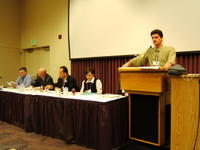 Given the media convergence happening in the Salt Lake City market, Utah seemed like an ideal place for scholars to gather to talk about cross-media partnerships and the promises and possibilities they bring to news gathering.
Given the media convergence happening in the Salt Lake City market, Utah seemed like an ideal place for scholars to gather to talk about cross-media partnerships and the promises and possibilities they bring to news gathering.In the nation’s 36th largest market, there are actually two cross-media partnerships, the biggest of which involves NBC affiliate KSL-TV Channel 5, KSL’s AM and FM radio stations and the Deseret Morning News that are all owned by the Church of Jesus Christ of Latter Day Saints.
Representatives from the television and newspaper partners visited the Brigham Young University campus Friday to share their take on “convergent realities” during a panel at the Fourth Annual Conference on Media Convergence.
Besides not having time to figure out what convergence means for all of their reporters, the managers from the Morning News and KSL-TV said they recognize the strengths possible with the partnership while at the same time expressing some concern about the multimedia preparation of their future reporters and editors.
“I have yet to see an applicant to showcase multimedia talent,” said Maria Titze, managing editor at KSL-TV.
Even as educators attending the convergence conference voiced concern about mixed messages they receive about the type of graduate most desired in the industry, the managers from KSL and Morning News were certain they still want to hire employees with journalism basics.
“I have a lot of good reporters and I have a lot of good writers, but not many who can do both. If you are good at both, you can make money in this field and do well, “ said Tad Walch, Utah County Bureau Chief for the Morning News.
Hiring new talent in a convergent age was just one of the realities expressed by this panel of print and broadcast journalists.
Besides a second, although smaller-scale, convergence partnership in Utah’s only media market between CBS-owned and operated station, KUTV Channel 4 and The Salt Lake Tribune, the Morning News is tied to its morning newspaper competitor, the Tribune through a joint operating agreement involving advertising and circulation operations.
Despite having Utah’s most visited news website, KSL.com, which includes both the KSL TV and Radio brands, the online component of this convergence partnership does not include the Morning News.
“The hardest part of the website is being able to make it profitable,” said Steve Poulsen, vice president of marketing and promotions for both radio and TV broadcast units.
In its infancy, the convergence effort at Morning News’ Utah County Bureau in Provo is the biggest move yet in cross-media cooperation between these units.
Last May, a KSL-TV reporter and KSL-Radio reporter began working out of the newspaper’s bureau in the backyard of Brigham Young University.
Deseret Morning News Bureau Chief Tad Walch admits he at least thinks about his broadcast partners more, but the three units are far from a point of daily collaboration.
“When I say the phrase fully converged, I kind of cringe because we don’t do much in the sense that the academic model would think about,” said Walch.
Back at the main newsroom in Salt Lake City, the day-to-day cooperation and planning between TV, newspaper and radio continues even as some of the managers ask questions.
“We’ve yet to approach the frontier of backpack journalism. I’m not even sure if that’s what we want,” Titze said.
Thursday, October 13, 2005
Podcasting in Provo
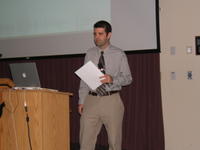 PROVO, Utah--A day after Apple CEO Steve Jobs unveiled the latest version of the iPod, a small but intensely interested group of mass media professors are taking their first voyage into the world of podcasting.
PROVO, Utah--A day after Apple CEO Steve Jobs unveiled the latest version of the iPod, a small but intensely interested group of mass media professors are taking their first voyage into the world of podcasting. The practice of publishing audio broadcasts via the Internet has become a virtual overnight success and this year is a part of the Fourth Annual Convergence Conference as all the speakers’ presentations are being made available for download through the conference website.
15 professors from across the country attending the conference came in a day early for a crash course in the technology used to prepare the audio broadcasts and have spent the last three days working to transform each of the more than two dozen presentations into MP3 files, which can be easily downloaded.
Ironically, the podcasting initiative came less than 24 hours after the video iPod was unveiled as the next generation of this portable music player that has produced a whole new culture surrounding totally customer-driven media content.
The new iPod, featuring a gorgeous 2.5-inch color screen, can display album artwork and photos, as well as play stunning video including music videos, video podcasts, home movies and television shows.
“To me podcasting is an example of true convergence,” said Christian Karlsson, who worked for the largest Apple retailer in Norway before enrolling in undergraduate studies at Brigham Young University.
“ A lot of different original media are using podcasting to reach a different audience.”
Karlsson points to Inside NYPD, a production of the New York Police Department and Newsweek on the Air, an extension of the Washington Post Company-owned weekly news magazine as examples of the wide range of podcasts being produced today.
Former public radio reporter and now radio documentary instructor Scott Lunt believes podcasting is here to stay because of its combination of technology and reduced costs of production.
“The shift is in the mentality,” said Lunt who he called the “democratization“ the podcasting brings.
“Now it’s inexpensive enough for me to go out to the web and have a couple hundred people listen to me.”
Lent, who is a graduate student at Brigham Young University, spearheaded this week’s Podcasting project.
The Latest From WashingtonPost.com


BYU students attended
tonight's keynote address by Washington Post.com Executive Editor James M. Brady.
James Brady would love for me to link to his website, WashingtonPost.com. The executive editor of the online sister to The Washington Post says when bloggers link to an article on his site, he links right back to the blog.
It’s part of the new age of audience convergence Brady spoke of during an address to a packed auditorium of mostly Brigham Young University students and attendees at the convergence conference tonight.
“The rise of blogs has begun to turn the media business from a lecture into a conversation,” said Brady, who returned to Washington Post.com nine months ago after working several years at America Online.
Not only is his web site linking to blogs, but it’s creating them too. According to Brady, WashingtonPost.com has created more than 20 blogs just in the last nine months.
The influence of blogging was just one many topics he covered in an address focused mostly on changing audience habits and challenges for his site.
“People have subject loyalty rather than brand loyalty,” he said.
When Brady leaves the newsroom of the WashingtonPost.com, he never knows when big news will break.
Earlier this summer, minutes after explaining to a class at American University what the website’s strategy would be in the event Pope John Paul II passed away, news broke of the late Pope’s passing.
Almost instantly, the website changed displaying a menu of news offerings on the story including live chats and photo galleries.
“They were so fascinated by the way when that story happened we were not limited by the ways we were able to tell that story,” he said.
More recently, Brady is proud of his site’s coverage of the recent hurricanes and how he was able to send his own crew of videographers to gather content for both Hurricane Katrina and Hurricane Rita.
Before becoming the executive editor of the site, Brady worked for AOL.com.
The Washington Post site, which launched in June 1996, is now competing head-to-head with other news websites that provide both national and local content.
With an editorial staff of 100 including 14 people devoted to multimedia content, four videographers and a half-dozen employees who take in video, Brady readily admits most of his content still comes from what he calls the “print parent” The Washington Post.
The two are part of the larger Washington Post Company, which includes Washington Post Newsweek Interactive (WPNI) of which the newspaper and magazine’s websites along with Slate.com are subsidiaries.
According to Brady, Washington Post had 2.3 billion page views in 2004 and WPNI made a profit, something not many online news sites can say.
Convergence Conference Begins

 Coats and jackets were the most appropriate attire as we headed to the University's Conference Center for a half-day Podcasting Pre-Conference.
Coats and jackets were the most appropriate attire as we headed to the University's Conference Center for a half-day Podcasting Pre-Conference.The morning temperatures here were in the 40s. But, by mid-day everything warmed up. In the fact, it was warm enough for air conditioners by this afternoon.
BYU Professor Quint Randle, who has attended all three previous conferences at the University of South Carolina is serving as host this year. At the right, you see Quint giving us our marching orders for the day.
A small, but growing community of convergence movers and shakers has temporarily shifted its annual gathering place from Columbia, South Carolina to Provo, Utah.
This is the fourth year for the Convergence Conference, which began in 2002 as the Newsplex at the University of South Carolina opened.
Each fall academic researchers have gathered to share various convergence-related projects on which they’re working while engaging in the ongoing debate about definitions of convergence and what it means for journalism and mass communication programs.
Most of today’s presentations focused on teaching strategies and struggles to keep ahead of the technology as we prepare tomorrow’s journalists and mass communicators.
Wednesday, October 12, 2005
WELCOME TO PROVO!

Two smooth plane rides and about 8 hours of travel later and I'm sitting in my home for the next four days. Provo, Utah is absolutely beautiful-- at least the mountain ranges. The Wasatch Mountain Range divides Provo from Salt Lake City, where the airport is located. I'll spare you the chamber of commerce introduction to my new home. But, at least we're here. The weather is fabulous-- no jackets needed during the day. But it's going down to 37 degrees here tonight. Check out Amy, the desk clerk who along with Mike (who took the photo) helped me produce this first posting from Provo.
Tuesday, October 11, 2005
EXCITED ABOUT UTAH!

Here's my first real web log posting on my new ALABAMA PRODUCER blog! The photos that preceded this posting were not real postings. Those who know me well also know I like to write and talk and e-mail. Now those of you who are patient will get a chance to read my postings to this blog.
I'm still trying to figure out how add some elements to the page. But, for now, it's up and running. In just about 12 hours, I will be taking off for the western U.S. to Provo, Utah for the Convergence Conference sponsored by Brigham Young University's Department of Communications. I am expecting great things as I share some of the things I have been doing on convergence both in my teaching and research.
I hope to be able to log in here several times during the next few days and record some of the observations. In the meantime, check out the conference web site to see what we'll be doing over the next three or four days. In the meantime, please pray for safe travels and that I will make all the flight connections as I head to the conference.

Tom Berg handed off the District II Conference host responsibility to Glenda Williams, who will become District II representative to the BEA Board in April 2006. Glenda Williams and her institution, the University of Alabama, will host the 2006 District II Conference in Tuscaloosa, Ala. I'm looking forward to being a part of the host team.









